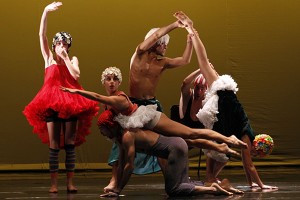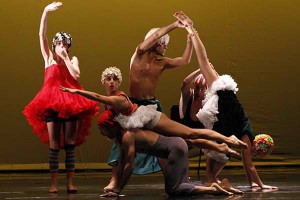By PABLO A. TARIMAN
 THE coming of an Italian dance company to Manila to showcase contemporary choreographic works inspired by legendary Italian film-maker Federico Fellini will surely bring back memories of lasting musical ties between the Philippines and Italy.
THE coming of an Italian dance company to Manila to showcase contemporary choreographic works inspired by legendary Italian film-maker Federico Fellini will surely bring back memories of lasting musical ties between the Philippines and Italy.
The dance event, called “I Bislacchi Omaggio a Fellini,” (Eccentrics, Homage to Fellini), is a production of Italian dance company Compagnia Artemis Danza in coordination with the Embassy of the Republic of Italy and Philippine Italian Association set on October 27 at the Cultural Center of the Philippines (CCP) main theater.
To be unraveled in dance form are images of “La Dolce Vita’s” famous Flying Christ and Trevi Fountain scenes, “La Strada’s” motley collection of circus characters, and 8 1/2′s rambling dreams and fantasies conceived and choreographed by the dance company’s artistic director Monica Casadei.
The timeless film music of Italian composer Nino Rota will be used in the dance concert that will surely evoke images, scenes and characters from popular Fellini films, namely, “La Strada,” “Amarconi,” “La Dolce Vita,” “Intervista,” “Casanova,” and “8 1/2.”
The Fellini films were much appreciated in the Philippines in the 1970s. A favorite was Fellini’s “Roma,” which satirized Catholic religious rituals through a fashion show of holy vestments complete with flashing electric bulbs.
The Filipino-Italian musical ties go back a long way even before the advent of Armani suits and Prada bags.
It all started with the visit of Italian opera companies at the turn of the century, peaking in the 1920s and 1930s with the emergence of first-rate Filipino singers invading Italian opera houses, including the most-feared La Scala (where even the likes of renowned opera singers Luciano Pavarotti and Maria Callas got booed).
The La Scala debuts the Philippines’ foremost bass baritone Jose Mossesgeld Santiago-Font in 1932 and tenor Arthur Espiritu in 2007, proof that Filipino talents are equal to the best in the world.
The country’s first operatic divas — Maestra Isang Tapales and National Artist for Music Jovita Fuentes — made their first international debut in Italy in 1924 as Cio Cio San in the Puccini opera, “Madama Butterfly.”
Tapales had sung 1,047 performances of “Madama Butterfly” (as Cio Cio San), more than 200 Bohemes (as Mimi) and Pagliacci (as Nedda) and over a hundred Iris.
She was the first Filipino soprano to sing with such renowned Italian tenors as Giacomo Lauri-Volpi and Beniamino Gigli. The latter inherited the crown of Enrico Caruso before the electronic age of Placido Domingo and the late Pavarotti.
Soprano Amelita Gulli-Curci, Italy’s operatic star of the 1920s and 1930s, performed at the Manila Metropolitan Theater and appeared in several operatic productions with Jose Mossesgeld Santiago-Font in Milan.
Renata Tebaldi, known as Maria Callas’s fierce rival, sang in Manila in the 1970s with Franco Corelli, another idol of Pavarotti. The goddess of opera that she was, Tebaldi proved she was human too when she cracked in a “Manon Lescaut aria” at the Philamlife Theater.
After that unfortunate incident, she massaged her throat with her hands, genuflected and bowed to ask for apology. She was greeted — not with boos — but with a grand applause.
Pavarotti’s first teacher Arrigo Pola sang in a Filipino film and played the role of Manrico in the 1953 staging of Verdi’s Il Trovatore, presented by a Filipino opera company chaired by Charito Planas with Tapales as artistic director. It featured the Leonora of soprano Remedios Bosch Jimenez, who was cited Soprano of the Year for that performance.
Pola even endorsed San Miguel beer in the old souvenir programs of the Manila Symphony at the neglected Manila Metropolitan Theater.
In the early 1980s, a tenor named Noel Velasco made opera headlines by winning the First Luciano Pavarotti International Voice Competitions in Philadelphia in 1981.
Italy’s foremost mezzo, Cecilia Bartoli, got the experience of her life when the country’s leading pianist, Cecile Licad,beautifully accompanied her in the Mostly Mozart Festival in Tokyo in the mid-1990s.
Pavarotti performed in Manila in 1994. The last Filipino artist Pavarotti encountered was conductor Julian Quirit, who conducted his last concert in Australia.
Quirit, who helped score the Australian hit film “Crocodile Dundee,” was also the first Filipino conductor to conduct — not just Pavarotti — but also his opera pal, Jose Carreras, all in Australia.
One of the country’s emerging divas, Rachelle Gerodias, took master classes from another Italian opera icon , Mirella Freni in Italy. In one session, Freni noted that the Filipino soprano sounded more Italian than real Italian singers.
After her triumphant Liu (Turandot) in Vienna, Gerodias debuted last week as Rosina in the Korean production of “Barber of Seville” at the Daegu Opera House in Korea.
The coming dance concert of Compagnia Artemis Danza indeed brings back memories of the golden days of opera in Manila when the city was referred to as the “Milan of the Orient” because of the proliferation of opera productions and the emergence of world-class Filipino operatic talents.
